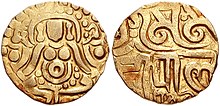Mahipala
| Mahipala | |
|---|---|
 Coin of the Pala Empire, Mahipala I and later. c.988–1161 | |
| Pala Emperor | |
| Reign | 988–1038 |
| Predecessor | Vigrahapala II |
| Successor | Nayapala |
| Issue | Nayapala |
| Dynasty | Pala |
| Father | Vigrahapala II |
| Religion | Shaivism[1] |
Mahipala (or Mahipala I; r. 988–1038) was a notable king of the Pala dynasty, which ruled over much of the eastern regions of the Indian subcontinent between the 8th and 12th centuries. He was the son and successor of Vigrahapala II. Mahipala's reign marked a resurgence in fortunes for the Pala empire, whose boundaries were expanded as far as Varanasi. However, his rule was temporarily hampered by the northern expedition of the Chola Emperor, Rajendra I.[2][3]
The Palas continued to patronise Shaivism, and epigraphic evidence suggests that Mahipala I and Nayapala were initiated as Shaivites by their royal preceptors. Vigrahapala III's Amagachi inscription describes him as "devoted to Śiva worship", and this tradition continued under his successor Ramapala. Poet Sandhyakar Nandi describes Ramapala's son Madanapala as a devotee of Shiva.[4]
Mahipala was succeeded by his son, Nayapala.[5]
See also
[edit]References
[edit]- ^ Alexis Sanderson (2009). "The Śaiva Age: The Rise and Dominance of Śaivism during the Early Medieval Period".
- ^ Kulke, Hermann; Rothermund, Dietmar (2007). A history of India (4th ed.). Routledge. p. 118. ISBN 9780415329200. Retrieved 4 September 2015.
- ^ "Pala dynasty". Encyclopædia Britannica. Retrieved 4 September 2015.
- ^ Mirnig, Nina (28 July 2020), "Adapting Śaiva Tantric Initiation for Exoteric Circles: The Lokadharmiṇī Dīkṣā and Its History in Early Medieval Sources", Śaivism and the Tantric Traditions, BRILL, pp. 249–282, ISBN 978-90-04-43280-2, retrieved 18 February 2024
- ^ Majumdar, Ramesh Chandra (2007). Ancient India (8th ed.). Delhi: Motilal Banarsidass. p. 318. ISBN 9788120804364. Retrieved 4 September 2015.
